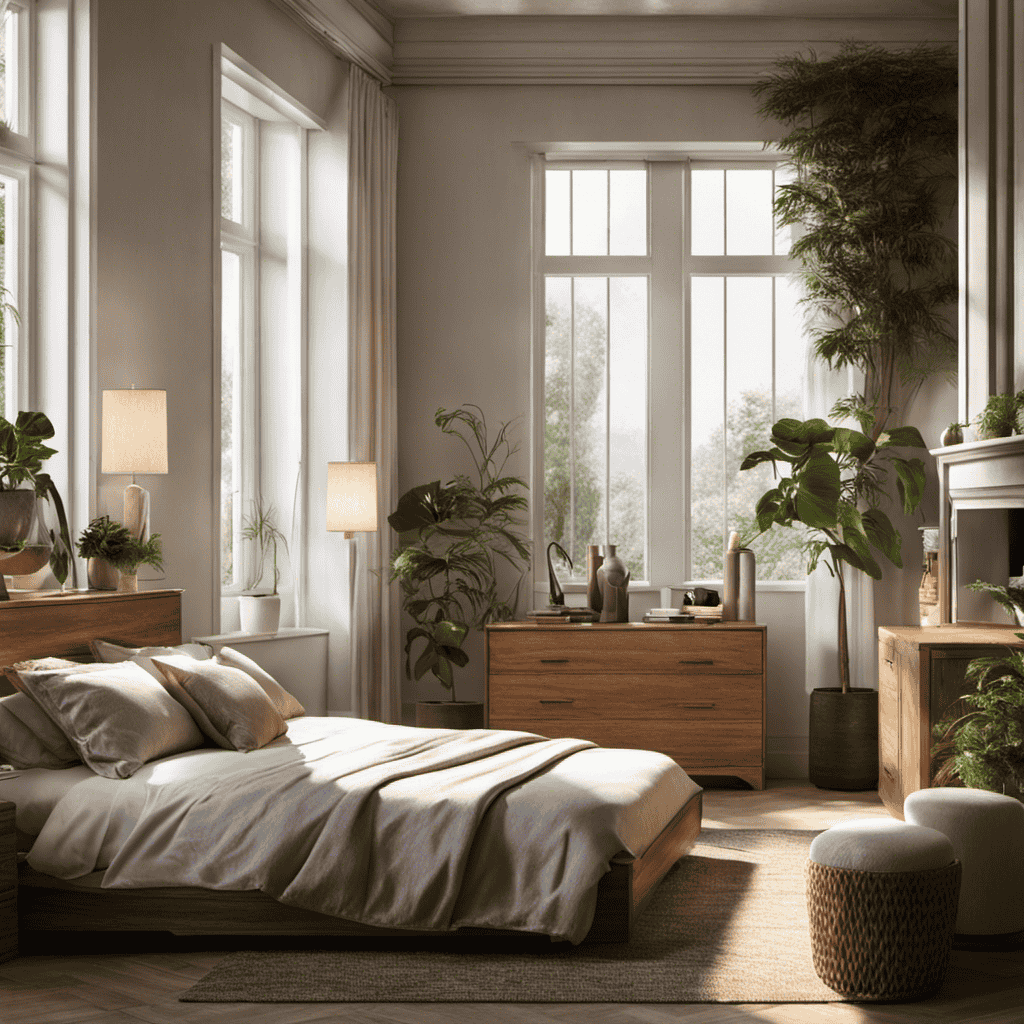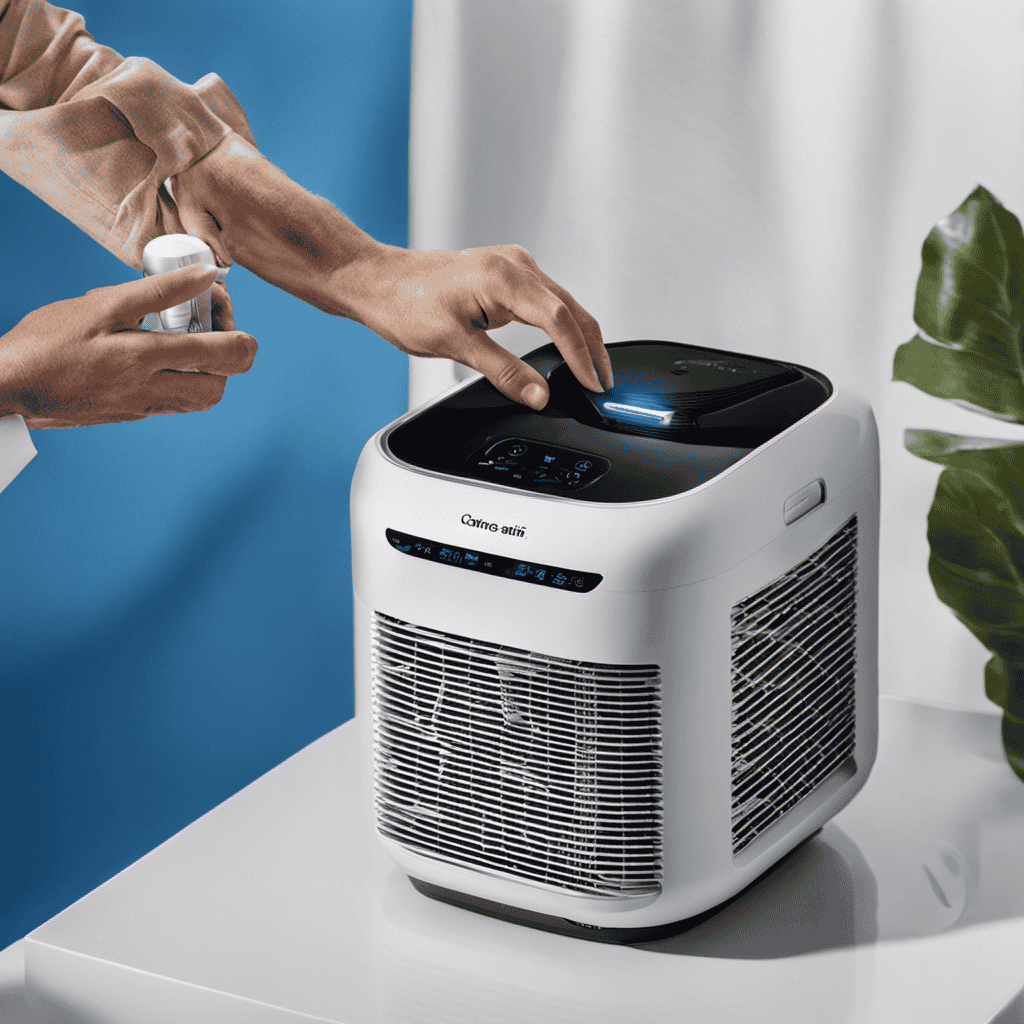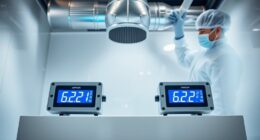As someone who is passionate about space, I find the intricate systems that enable astronauts to thrive in the demanding conditions of outer space utterly fascinating.
One such crucial system is air purification, which plays a vital role in maintaining clean and breathable air inside spacecraft.
In this article, we will delve into the various types of air purification systems used in space missions, explore NASA’s approach to this vital aspect, and discuss the future developments in air purification technology for space exploration.
Join me on this journey as we uncover the secrets of keeping the air clean in space.
Key Takeaways
- High-efficiency particulate air (HEPA) filters are used in spacecraft air purification systems.
- Activated carbon filters are employed to remove volatile organic compounds (VOCs) and harmful gases.
- Air quality monitoring using highly sensitive sensors is crucial for maintaining clean air in spacecraft.
- Regular maintenance and replacement of filters are essential for the effective functioning of air purifiers.
The Importance of Air Purification in Spacecraft
Air purification is crucial in spacecraft to ensure the safety and well-being of astronauts. The importance of air quality cannot be overstated in the confined and isolated environment of a spacecraft. With limited access to fresh air and the presence of various contaminants, maintaining clean and breathable air is essential for the health and performance of the crew.
Advancements in filtration technology have greatly improved the efficiency and effectiveness of air purification systems in spacecraft. These advancements include the development of high-efficiency particulate air (HEPA) filters that can remove particles as small as 0.3 micrometers, as well as the integration of activated carbon filters for the removal of volatile organic compounds (VOCs) and other harmful gases.
These filtration technologies work together to ensure that the air inside the spacecraft is clean, safe, and of high quality, providing a healthy and habitable environment for astronauts.
The Challenges of Maintaining Clean Air in Spacecraft
Air quality monitoring is a crucial aspect of maintaining clean air in spacecraft. It involves continuous monitoring and analysis of various air pollutants such as carbon dioxide, volatile organic compounds, and particulate matter.
The efficiency of the filtration system is also vital in removing these pollutants and ensuring a healthy environment for astronauts.
Furthermore, long-term health implications need to be considered, as prolonged exposure to poor air quality can lead to respiratory issues and other health problems for astronauts.
Air Quality Monitoring
To ensure the safety of your breathing environment, you’ll want to monitor the quality of the air in your spacecraft. Indoor air pollution can be a serious issue in confined spaces, leading to health problems for astronauts.
Here are four important aspects of air quality monitoring in spacecraft:
-
Sensors: Highly sensitive sensors are used to detect and measure various pollutants present in the air, such as carbon dioxide, formaldehyde, and volatile organic compounds (VOCs).
-
Data Analysis: The collected data is analyzed in real-time to identify any potential threats to the air quality. This allows for timely interventions to maintain a clean and healthy environment.
-
Filtration Systems: Advanced air purifier technology is employed to remove contaminants from the air, ensuring that astronauts have access to clean and breathable air throughout their mission.
-
Maintenance and Calibration: Regular maintenance and calibration of the air quality monitoring system is crucial to ensure accurate and reliable results.
Filtration System Efficiency
To ensure the efficiency of your filtration system, you’ll need to regularly clean and replace the filters. Proper maintenance is crucial for the effective functioning of your air purifier. The filtration system design plays a significant role in ensuring clean and breathable air. It consists of multiple filters that capture and remove particles, allergens, and pollutants from the air. The table below provides an overview of the different filters commonly used in filtration systems:
| Filter Type | Function |
|---|---|
| Pre-filter | Captures large particles |
| HEPA filter | Removes small particles |
| Activated | Absorbs odor and |
| Carbon filter | harmful gases |
| UV-C light | Kills bacteria and viruses |
Regular maintenance, such as cleaning or replacing filters, is essential for optimal performance. It helps prolong the lifespan of the filters and ensures that they continue to effectively capture and remove pollutants from the air. Neglecting maintenance can result in reduced filtration efficiency and compromised air quality. Therefore, it is crucial to follow the manufacturer’s guidelines for maintenance and replace filters as recommended.
Long-Term Health Implications
Regularly cleaning and replacing filters in your air purifier is crucial for maintaining long-term health and ensuring clean and breathable air. Neglecting this important maintenance can have serious consequences for your well-being, especially in the context of space travel. Here are four reasons why proper filter maintenance is essential in space:
-
Long-term health effects: In the confined environment of a spacecraft, the accumulation of airborne pollutants can lead to respiratory problems, allergies, and even more serious conditions over time.
-
Space travel consequences: Microgravity conditions can exacerbate the effects of poor air quality. Without the Earth’s natural filtration systems, such as gravity and atmospheric circulation, airborne contaminants can linger longer and pose a greater risk to astronauts.
-
System efficiency: Clean filters ensure that the air purifier operates at maximum efficiency, effectively removing harmful particles and maintaining optimal air quality.
-
Respiratory protection: Filters act as a barrier, trapping dust, allergens, and other pollutants before they enter your lungs. Regularly cleaning and replacing them ensures that you continue to breathe in clean and healthy air.
Taking care of your air purifier’s filters is not only essential for maintaining long-term health, but also for mitigating the unique consequences of space travel on air quality.
Understanding the Role of Air Purifiers in Space Missions
Air purifiers play a crucial role in space missions by maintaining the air quality for astronauts. Just like in homes, air purifiers in spacecraft are designed to remove pollutants and contaminants from the air, ensuring a clean and healthy breathing environment.
Clean air is essential for the well-being of astronauts as it helps prevent respiratory issues and other health problems that may arise from breathing in contaminated air. In the confined and isolated space of a spacecraft, maintaining air quality becomes even more important.
Air purifiers help in removing harmful substances such as dust, allergens, and volatile organic compounds (VOCs), creating a safer atmosphere for astronauts. They also help control humidity and prevent the buildup of mold and bacteria, reducing the risk of respiratory infections.
Overall, air purifiers in space missions contribute to the overall health and well-being of astronauts by providing them with clean and purified air.
Types of Air Purification Systems Used in Spacecraft
When it comes to maintaining air quality in spacecraft, you’ll find various types of air purification systems in use. These systems play a crucial role in ensuring the health and well-being of astronauts in the confined space environment.
Here are the four main types of filtration systems used in spacecraft:
-
High-Efficiency Particulate Air (HEPA) Filters: These filters are designed to capture and remove small particles, such as dust, pollen, and bacteria, from the air. They are highly effective in improving air quality and reducing the risk of respiratory issues for astronauts.
-
Activated Carbon Filters: These filters use a special type of carbon that can adsorb gases and odors. They help eliminate harmful chemicals and volatile organic compounds (VOCs) from the air, creating a safer breathing environment for astronauts.
-
Photocatalytic Oxidation (PCO) Filters: PCO filters use a combination of UV light and a catalyst to break down airborne contaminants, including viruses and bacteria. They are particularly effective in reducing the spread of pathogens and preventing infections among astronauts.
-
Electrostatic Precipitators: These filters use an electric charge to attract and capture particles in the air. They are highly efficient in removing allergens, smoke, and other particulate matter, ensuring a cleaner and healthier breathing space for astronauts.
The impact of these air purification systems on astronaut health cannot be overstated. By effectively removing airborne contaminants, these filtration systems help minimize the risk of respiratory issues, allergies, and infections, ensuring a safer and more comfortable environment for astronauts during their space missions.
NASA’s Approach to Air Purification in Spacecraft
NASA’s approach to air purification in spacecraft is of utmost importance due to the critical need for clean air in order to ensure the health and well-being of astronauts during their missions.
The methods employed by NASA for air purification are carefully designed to effectively remove contaminants and maintain a high level of air quality.
The spacecraft air quality is constantly monitored to ensure that the air purification systems are functioning optimally and providing a safe and healthy environment for the astronauts.
Nasa’s Air Purification Methods
You can learn about NASA’s air purification methods for spacecraft. When it comes to purifying air in space, NASA faces several challenges due to the unique environment and limited resources. However, they have developed innovative solutions to overcome these obstacles and ensure the safety and well-being of astronauts. Here are four key techniques used by NASA for air purification in spacecraft:
-
Filtration: NASA employs advanced filtration systems to remove particulate matter, dust, and other contaminants from the air. These filters are designed to be highly efficient and durable, capable of trapping even the smallest particles.
-
Adsorption: NASA utilizes adsorbent materials like activated carbon to remove volatile organic compounds (VOCs) and odors from the air. These materials have a high surface area and can attract and trap harmful substances.
-
Electrostatic Precipitation: This method involves charging the particles in the air and then collecting them on oppositely charged plates. It is effective in removing microscopic particles and aerosols from the air.
-
Photocatalysis: NASA has developed photocatalytic systems that use ultraviolet (UV) light and a catalyst to break down organic compounds into harmless substances. This process helps to eliminate any residual contaminants in the air.
Through these innovative air purification methods, NASA ensures a clean and healthy environment for astronauts during space missions.
Importance of Clean Air
Clean air is essential for the health and well-being of astronauts during space missions. Breathing in clean air provides numerous benefits, ensuring a safe and comfortable environment for astronauts to live and work in. Clean air helps to maintain the proper oxygen levels needed for respiration, preventing the negative effects of low oxygen levels such as fatigue, dizziness, and impaired cognitive function.
Additionally, clean air reduces the risk of respiratory illnesses and infections, which can be detrimental to astronauts in the confined space of a spacecraft. On the other hand, air pollution poses a serious threat to human health. Exposure to polluted air can lead to respiratory problems, cardiovascular diseases, and even cancer.
Therefore, ensuring clean air is crucial for the overall well-being of astronauts during their space missions.
Spacecraft Air Quality
Maintaining a healthy and breathable environment is crucial for the well-being of astronauts during space missions. In order to ensure their health and safety, spacecraft are equipped with advanced air circulation systems. Here are four key aspects of spacecraft air quality:
-
Filtration: The air inside the spacecraft is filtered to remove particles, such as dust and microbes, that could pose a threat to astronaut health.
-
Ventilation: Proper ventilation is essential to circulate the filtered air throughout the spacecraft, ensuring a constant supply of fresh oxygen.
-
Humidity control: Maintaining optimal humidity levels helps prevent the growth of mold and bacteria, which could lead to respiratory issues for astronauts.
-
Carbon dioxide removal: Efficient systems are in place to remove excess carbon dioxide exhaled by the astronauts, ensuring a safe and breathable atmosphere.
These measures are vital for the health and safety of astronauts during space missions. However, continuous advancements in air purification technology are being made to further enhance the quality of air in spacecraft.
Innovations in Air Purification Technology for Space Missions
The latest innovations in air purification technology for space missions have greatly improved the quality of air in spacecraft. Advanced air purification techniques and spacecraft air filtration systems play a crucial role in ensuring the health and safety of astronauts during their missions. These systems are designed to remove contaminants and maintain optimal air quality within the confined spaces of a spacecraft.
One of the key advancements in air purification technology is the use of high-efficiency particulate air (HEPA) filters. These filters are capable of trapping microscopic particles, such as dust, pollen, and bacteria, ensuring that the air inside the spacecraft remains clean and free from harmful pollutants. Additionally, activated carbon filters are used to remove odors and volatile organic compounds (VOCs) from the air.
Table: Air Purification Technologies in Spacecraft
| Air Purification Technology | Description |
|---|---|
| High-efficiency particulate air (HEPA) filters | Traps microscopic particles and contaminants |
| Activated carbon filters | Removes odors and volatile organic compounds |
| UV-C radiation | Kills bacteria and viruses |
Another important innovation is the use of UV-C radiation to kill bacteria and viruses in the air. This technology helps to prevent the spread of infections and ensures a safer environment for astronauts. Overall, these advancements in air purification technology have significantly improved the quality of air in spacecraft, creating a healthier and more comfortable living space for astronauts during their missions.
Testing and Certification of Air Purifiers for Spacecraft
UV-C radiation is an effective method for killing bacteria and viruses in the air, ensuring a safer environment for astronauts during space missions. When it comes to air purifiers for spacecraft, testing protocols and quality standards are of utmost importance. Here are four key aspects of testing and certification that ensure the efficiency and reliability of air purifiers in space:
-
Testing protocols: Rigorous testing procedures are necessary to evaluate the performance of air purifiers in eliminating airborne contaminants. These protocols involve subjecting the purifiers to various conditions, such as high humidity and extreme temperatures, to ensure their effectiveness in different environments.
-
Quality standards: Air purifiers for spacecraft must meet specific quality standards set by space agencies. These standards ensure that the purifiers meet the necessary requirements for effective air purification and are safe for use in the confined environment of a spacecraft.
-
Certification process: Air purifiers undergo a certification process to verify their compliance with the testing protocols and quality standards. This process involves thorough inspections, testing, and documentation to ensure that the purifiers meet the necessary criteria for space missions.
-
Continuous monitoring: Even after certification, air purifiers are continuously monitored to ensure their ongoing effectiveness. This includes periodic inspections and maintenance to guarantee that the purifiers are functioning optimally and providing a safe and clean air environment for astronauts.
Future Developments in Air Purification for Space Exploration
As technology advances, future developments in air purification for space exploration will focus on improving efficiency, reliability, and compactness to enhance astronaut safety and comfort.
With the increasing demands of long-duration space missions, it is imperative to enhance the performance of air purification systems to ensure the well-being of astronauts.
One of the key future advancements in this field is the utilization of advanced filtration technologies, such as nanofiber filters, which can effectively capture even the smallest particles and microorganisms.
Additionally, the integration of smart sensors and artificial intelligence algorithms will enable real-time monitoring of air quality parameters and automatic adjustment of the purification system settings.
Furthermore, the development of compact and lightweight air purifiers will help save valuable space on spacecraft while maintaining high purification efficiency.
These new technologies will revolutionize air purification for space exploration, making it more efficient, reliable, and suitable for long-duration missions.
Frequently Asked Questions
How Long Can Astronauts Stay in a Spacecraft Without the Use of Air Purifiers?
Without the use of air purifiers, astronauts can stay in a spacecraft for a limited time before experiencing potential effects on their health. This is a crucial consideration for space exploration missions where clean and breathable air is essential.
What Are the Potential Health Risks for Astronauts if Air Purification Systems Are Not Used in Spacecraft?
Potential health risks for astronauts without air purification systems include respiratory problems, allergies, and exposure to harmful gases. Preventive measures include regular maintenance of filtration systems and monitoring air quality to ensure a safe environment.
Are Astronauts Responsible for Maintaining the Air Purification Systems in the Spacecraft?
Yes, astronauts are responsible for maintaining the air purification systems in the spacecraft. Regular maintenance is crucial to ensure clean and safe air for the crew. Neglecting this duty can lead to serious health risks.
How Do Air Purification Systems in Spacecraft Differ From Those Used in Terrestrial Environments?
In space, air purification systems differ from those on Earth due to the unique challenges of the environment. These systems are designed to remove contaminants, such as carbon dioxide, and ensure the astronauts’ safety. The benefits include maintaining a healthy living environment and sustaining life during space missions.
Can Air Purifiers in Spacecraft Remove All Types of Contaminants, Including Gases and Bacteria?
Yes, air purifiers in spacecraft can remove various contaminants, including gases and bacteria. The air purifier technology used is highly effective, ensuring the air quality is maintained for astronauts’ safety and well-being.
Conclusion
In conclusion, the importance of air purification in spacecraft cannot be overstated. Without it, astronauts would be exposed to harmful contaminants, jeopardizing their health and mission success.
The challenges of maintaining clean air in space are immense, but thanks to innovative air purification technology, NASA is leading the way in ensuring astronauts breathe safe and clean air.
As we venture further into space exploration, the development of advanced air purification systems will continue to be crucial for the well-being and survival of our brave astronauts.










